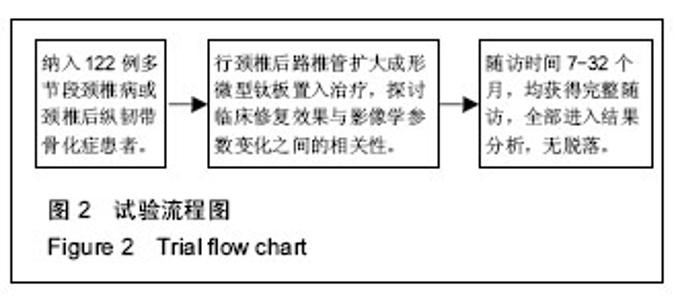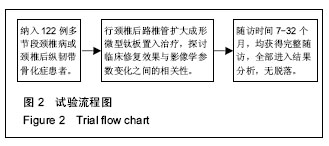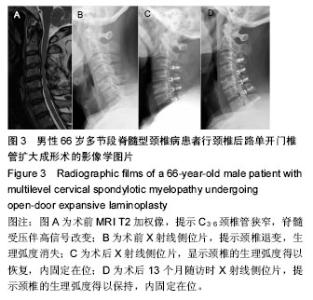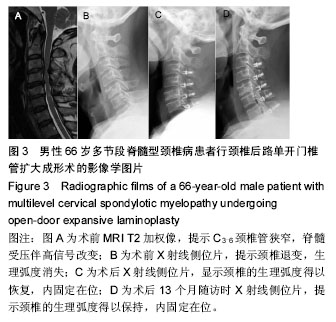Chinese Journal of Tissue Engineering Research ›› 2016, Vol. 20 ›› Issue (44): 6570-6576.doi: 10.3969/j.issn.2095-4344.2016.44.005
Previous Articles Next Articles
Posterior cervical open-door expansive laminoplasty with mini-titanium plate: correlation between cervical sagittal alignment and repair effect
Gu Yong, Wang Qiang, Xin Tian-wen, Yang Hui-lin, Chen Liang
- Department of Orthopedic Surgery, the First Affiliated Hospital of Soochow University, Suzhou 215006, Jiangsu Province, China
-
Revised:2016-09-06Online:2016-10-28Published:2016-10-28 -
Contact:Chen Liang, Chief physician, Professor, Doctoral supervisor, Department of Orthopedic Surgery, the First Affiliated Hospital of Soochow University, Suzhou 215006, Jiangsu Province, China -
About author:Gu Yong, Master, Attending physician, Department of Orthopedic Surgery, the First Affiliated Hospital of Soochow University, Suzhou 215006, Jiangsu Province, China -
Supported by:the General Program of National Natural Science Foundation of China, No. 81371930; the Social Development-Standardized Diagnosis and Treatment Project of Key Special Disease in Jiangsu Province, No. BE2015641; the General Program of Natural Science Foundation of Higher Learning Schools of Jiangsu Province, No. 15KJB320012
CLC Number:
Cite this article
Gu Yong, Wang Qiang, Xin Tian-wen, Yang Hui-lin, Chen Liang . Posterior cervical open-door expansive laminoplasty with mini-titanium plate: correlation between cervical sagittal alignment and repair effect[J]. Chinese Journal of Tissue Engineering Research, 2016, 20(44): 6570-6576.
share this article
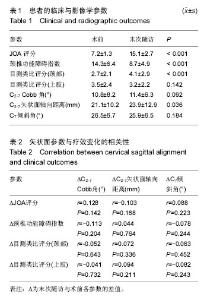
2.2 基线资料分析 减压节段均为C3-C7,常规5个节段,固定3-5个节段,平均(4.5±0.5)个;手术时间90-230 min,平均(168.4±50.2) min;术中出血量200-700 mL,平均(415.6±206.4)mL;住院时间8-22 d,平均(11.6±2.5) d。 2.3 临床与影像学矢状面参数分析 末次随访时JOA评分及颈椎功能障碍指数均较术前明显改善(P < 0.001)。颈部目测类比评分较术前增加(P < 0.001),而上肢目测类比评分无明显变化(P=0.142)。末次随访时C2-7矢状面轴向距离较术前增加(P=0.036);而C2-7前凸角及C7倾斜角与术前比较无明显变化(P=0.092,P=0.184),见表1。 2.4 矢状面参数与临床疗效变化之间的相关性分析 C2-7 Cobb角、C2-7矢状面轴向距离及C7倾斜角等颈椎矢状位参数的变化与JOA评分、颈椎功能障碍指数及目测类比评分的改善并无明显相关性(P均> 0.05),见表2。"
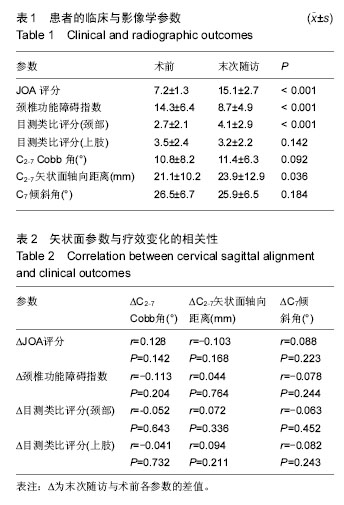
| [1] Liu W, Hu L, Chou PH, et al. Comparison of anterior decompression and fusion versus laminoplasty in the treatment of multilevel cervical ossification of the posterior longitudinal ligament: a systematic review and meta-analysis. Ther Clin Risk Manag. 2016;12:675-685.
[2] Wang LN, Wang L, Song YM, et al. Clinical and radiographic outcome of unilateral open-door laminoplasty with alternative levels centerpiece mini-plate fixation for cervical compressive myelopathy: a five-year follow-up study. Int Orthop. 2016;40(6):1267-1274.
[3] Chen GD, Lu Q, Sun JJ, et al. Effect and prognostic factors of laminoplasty for cervical myelopathy with an occupying ratio greater than 50. Spine. 2016;41(5): 378-383.
[4] Liu X, Wang H, Zhou Z, et al. Anterior decompression and fusion versus posterior laminoplasty for multilevel cervical compressive myelopathy. Orthopedics. 2014; 37(2):e117-122.
[5] Kimura A, Endo T, Inoue H, et al. Impact of axial neck pain on quality of life after laminoplasty. Spine. 2015; 40(24): E1292-1298.
[6] Yuan W, Zhu Y, Liu X, et al. Laminoplasty versus skip laminectomy for the treatment of multilevel cervical spondylotic myelopathy: a systematic review. Arch Orthop Trauma Surg. 2014;134(1):1-7.
[7] Yamanaka K, Tachibana T, Moriyama T, et al. C-5 palsy after cervical laminoplasty with instrumented posterior fusion. J Neurosurg Spine. 2014;20(1):1-4.
[8] Healy AT, Lubelski D, West JL, et al. Biomechanics of open-door laminoplasty with and without preservation of posterior structures. J Neurosurg Spine. 2016;24(5): 746-751.
[9] Chen H, Liu H, Deng Y, et al. Multivariate analysis of factors associated with axial symptoms in unilateral expansive open-door cervical laminoplasty with miniplate fixation. Medicine (Baltimore). 2016;95(2):e2292.
[10] Furlan JC, Catharine Craven B. Psychometric analysis and critical appraisal of the original, revised, and modified versions of theJapanese Orthopaedic Association score in the assessment of patients with cervical spondylotic myelopathy. Neurosurg Focus. 2016;40(6):E6.
[11] Vernon H, Mior S. The Neck Disability Index: a study of reliability and validity. J Manipulative Physiol Ther. 1991;14(7):409-415.
[12] Vernon H. The Neck Disability Index: state-of-the-art, 1991-2008. J Manipulative Physiol Ther. 2008;31(7): 491-502.
[13] .Wewers ME, Lowe NK. A critical review of visual analogue scales in the measurement of clinical phenomena. Res Nurs Health.1990;13(4):227-236.
[14] Scheer JK, Tang JA, Smith JS, et al. Cervical spine alignment, sagittal deformity, and clinical implications. Neurosurg Spine. 2013; 19:141-159.
[15] 邓元,倪斌.颈椎矢状序列测量方法的研究进展[J].中国脊柱脊髓杂志,2014,24(7):655-659.
[16] Núñez-Pereira S, Hitzl W, Bullmann V, et al. Sagittal balance of the cervical spine: an analysis of occipitocervical and spinopelvic interdependence, with C-7 slope as a marker of cervical and spinopelvic alignment. J Neurosurg Spine. 2015;23:16-23.
[17] Duetzmann S, Cole T, Ratliff JK. Cervical laminoplasty developments and trends, 2003-2013: a systematic review. J Neurosurg Spine. 2015;23(1):24-34.
[18] Machino M, Yukawa Y, Hida T, et al. Cervical alignment and range of motion after laminoplasty: radiographical data from more than 500 cases with cervical spondylotic myelopathy and a review of the literature. Spine. 2012;37(20):E1243-1250.
[19] Braly BA, Lunardini D, Cornett C, et al. Operative treatment of cervical myelopathy: cervical laminoplasty. Adv Orthop. 2012;2012:508534.
[20] 黄长智,林泉,袁燕林,等. Arch钛板在颈后路单开门椎管扩大成形治疗颈椎管狭窄症中的应用[J].颈腰痛杂志,2015,36(5):360-363.
[21] An HS, Al-Shihabi L, Kurd M. Surgical treatment for ossification of the posterior longitudinal ligament in the cervical spine. J Am Acad Orthop Surg. 2014;22(7): 420-429.
[22] 陈刚,戴腾,施克勤. 后路单开门椎管成形术与全椎板切除减压术治疗颈椎后纵韧带骨化症的对比研究[J]. 中国矫形外科杂志,2016,24(7):598-602.
[23] Lee CH, Lee J, Kang JD, et al. Laminoplasty versus laminectomy and fusion for multilevel cervical myelopathy: a meta-analysis of clinical and radiological outcomes. J Neurosurg Spine. 2015;22(6):589-595.
[24] Yoon ST, Hashimoto RE, Raich A, et al. Outcomes after laminoplasty compared with laminectomy and fusion in patients with cervical myelopathy: a systematic review. Spine. 2013;38 (22 Suppl 1): S183-194.
[25] Li XK, Liu X, Che L, et al. Cervical open-door laminoplasty technique with simple sutures and bone grafts: a single institutional study with 30 consecutive cases. J Orthop Surg Res. 2015;10:14.
[26] Yeh KT, Yu TC, Chen IH, et al. Expansive open-door laminoplasty secured with titanium miniplates is a good surgical method for multiple-level cervical stenosis. J Orthop Surg Res. 2014;9:49.
[27] Chen H, Deng Y, Li T, et al. Clinical and radiography results of mini-plate fixation compared to suture suspensory fixation incervical laminoplasty: A five-year follow-up study. Clin Neurol Neurosurg. 2015;138: 188-195.
[28] 陈欣,庄颖峰,孙宇,等.单开门颈椎管扩大椎板成形术治疗颈椎后纵韧带骨化症的中远期疗效观察[J]. 中国脊柱脊髓杂志,2015,25(12):1057-1062.
[29] Cho JH, Ha JK, Kim DC, et al. Does preoperative T1 slope affect radiological and functional outcomes after cervical laminoplasty? Spine. 2014;39(26):E1575-E1581.
[30] Machino M, Yukawa Y, Hida T, et al. Cervical alignment and range of motion after laminoplasty. Radiographical data from more than 500 cases with cervical spondylotic myelopathy and a review of the literature. Spine. 2012;37(20):E1243-E1250.
[31] Ames CP, Blondel B, Scheer JK, et al. Cervical radiographical alignment: comprehensive assessment techniques and potential importance in cervical myelopathy. Spine. 2013;38(22 Suppl 1): S149-160.
[32] Lee JS, Youn MS, Shin JK, et al. Relationship between cervical sagittal alignment and quality of life in ankylosing spondylitis. Eur Spine J. 2015;24(6): 1199-1203.
[33] 赵文奎,于淼,姜亮,等. 无症状成人颈椎矢状位曲度分析及其与全脊柱矢状位参数的关系[J]. 中国脊柱脊髓杂志, 2015,25(3): 231-237.
[34] Sakai K, Yoshii T, Hirai T, et al. Cervical sagittal imbalance is a predictor of kyphotic deformity after laminoplasty in cervical spondylotic myelopathy patients without preoperative kyphotic alignment. Spine. 2016;41(4):299-305.
[35] Lin S, Zhou F, Sun Y, et al. The severity of operative invasion to the posterior muscular-ligament complex influences cervical sagittal balance after open-door laminoplasty. Eur Spine J. 2015; 24:127-135.
[36] Smith JS, Lafage V, Ryan DJ, et al. Association of myelopathy scores with cervical sagittal balance and normalized spinal cord volume: analysis of 56 preoperative cases from the AOSpine North America Myelopathy Study. Spine. 2013; 38:S161-S170.
[37] 张浩,周文超,陈元元,等. 颈椎后纵韧带骨化症单开门椎管扩大成形术后颈椎矢状位参数变化与疗效的关系[J]. 中国脊柱脊髓杂志,2016,26(3):206-210.
[38] Lee CK, Shin DA, Yi S, et al. Correlation between cervical spine sagittal alignment and clinical outcome after cervical laminoplasty for ossification of the posterior longitudinal ligament. J Neurosurg Spine. 2016;24:100-107.
[39] Cheng Z, Chen W, Yan S, et al. Expansive open-door cervical laminoplasty: in situ reconstruction of extensor muscle insertion on the C2 spinous process combined with titanium miniplates internal fixation. Medicine (Baltimore). 2015;94(28):e1171.
[40] 李会明,夏刚,刘洋,等.颈椎单开门椎管成形术后C5 神经根麻痹的致病因素分析[J]. 天津医药,2016,44(3): 265-268.
[41] 王昊,王沛. 颈椎后路减压与脊髓后移位距离及轴性症状的关系[J]. 中国组织工程研究,2014,18(13):2037-2042. |
| [1] | Shi Bin, An Jing, Chen Long-gang, Zhang Nan, Tian Ye . Influencing factors for pain after total knee arthroplasty [J]. Chinese Journal of Tissue Engineering Research, 2017, 21(7): 993-997. |
| [2] | Wang Xian-xun. Impact of local compression cryotherapy combined with continuous passive motion on the early functional recovery after total knee arthroplasty [J]. Chinese Journal of Tissue Engineering Research, 2017, 21(7): 998-1003. |
| [3] | Yuan Wei, Zhao Hui, Ding Zhe-ru, Wu Yu-li, Wu Hai-shan, Qian Qi-rong. Association between psychological resilience and acute mental disorders after total knee arthroplasty [J]. Chinese Journal of Tissue Engineering Research, 2017, 21(7): 1015-1019. |
| [4] | Chen Qun-qun, Qiao Rong-qin, Duan Rui-qi, Hu Nian-hong, Li Zhao, Shao Min. Acu-Loc®2 volar distal radius bone plate system for repairing type C fracture of distal radius [J]. Chinese Journal of Tissue Engineering Research, 2017, 21(7): 1025-1030. |
| [5] | Huang Xiang-wang, Liu Hong-zhe. A new low elastic modulus of beta titanium alloy Ti2448 spinal pedicle screw fixation affects thoracic stability: biomechanical analysis [J]. Chinese Journal of Tissue Engineering Research, 2017, 21(7): 1031-1035. |
| [6] | Xie Qiang. Three-dimensional finite element model for biomechanical analysis of stress in knee inversion and external rotation after posterior cruciate ligament rupture [J]. Chinese Journal of Tissue Engineering Research, 2017, 21(7): 1036-1040. |
| [7] | He Ze-dong, Zhao Jing, Chen Liang-yu, Li Ke, Weng Jie. Multilevel finite element analysis on the biological tribology damage of water on bone tissue [J]. Chinese Journal of Tissue Engineering Research, 2017, 21(7): 1041-1045. |
| [8] | Jiang Zi-wei, Huang Feng, Cheng Si-yuan, Zheng Xiao-hui, Sun Shi-dong, Zhao Jing-tao, Cong Hai-chen,Sun Han-qiao, Dong Hang. Design and finite element analysis of digital splint [J]. Chinese Journal of Tissue Engineering Research, 2017, 21(7): 1052-1056. |
| [9] | Wang Fei, Liu Zhi-bin, Tao Hui-ren, Zhang Jian-hua, Li Chang-hong, Cao Qiang, Zheng Jun, Liu Yan-xiong, Qu Xiao-peng. Clinical efficacy of preoperative osteotomy designs using paper-cut technology versus photoshop software for ankylosing spondylitis with kyphosis [J]. Chinese Journal of Tissue Engineering Research, 2017, 21(7): 1057-1063. |
| [10] | Li Hui, Ma Jun-yi, Ma Yuan, Zhu Xu . Establishment of a three-dimensional finite element model of ankylosing spondylitis kyphosis [J]. Chinese Journal of Tissue Engineering Research, 2017, 21(7): 1069-1073. |
| [11] | Ling Guan-han, Ou Zhi-xue, Yao Lan, Wen Li-chun, Wang Guo-xiang, Lin Heng-feng. Establishment of simulating three-dimensional model of China-Japan Friendship Hospital Classification for L type osteonecrosis of the femoral head [J]. Chinese Journal of Tissue Engineering Research, 2017, 21(7): 1074-1079. |
| [12] | Fu Wei-min, Wang Ben-jie. Assessing the degree of necrotic femoral head, and association of blood supply with pathlogical changes: study protocol for a diagnostic animal trial [J]. Chinese Journal of Tissue Engineering Research, 2017, 21(7): 1086-1091. |
| [13] | Zhang Wen-qiang, Ding Qian, Zhang Na. Associations between alpha angle and herniation pit on oblique axial magnetic resonance imaging in asymptomatic hip joints of adults [J]. Chinese Journal of Tissue Engineering Research, 2017, 21(7): 1098-1103. |
| [14] | Sun Xiao-xin1, Zhou Wei2, Zuo Shu-ping3, Liu Hao1, Song Jing-feng1, Liang Chun-yu1. Morphological characteristics for the magnetic resonance imaging assessment of discoid lateral meniscal tears in children [J]. Chinese Journal of Tissue Engineering Research, 2017, 21(7): 1104-1109. |
| [15] | Lin Han-wen, Wen Jun-mao, Huang Chao-yuan, Zhou Chi, Tang Hong-yu. Correlation between the changes in lower limb power line and pain area in the knee osteoarthritis patients: imaging evaluation [J]. Chinese Journal of Tissue Engineering Research, 2017, 21(7): 1110-1114. |
| Viewed | ||||||
|
Full text |
|
|||||
|
Abstract |
|
|||||
